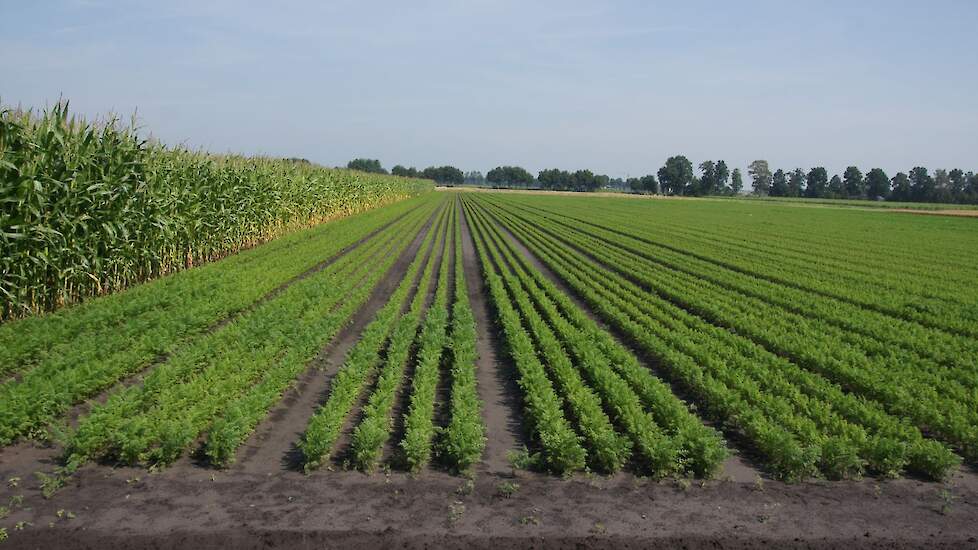In order to avoid costs for weed control, it is important to look quite far ahead with mechanical weed control. Marc Kroonen, manager of the practice research company Vredepeel, says that weeds should not spread, so that they become a problem in subsequent crops.
At the webinar ‘Bye, weeds’, Kroonen said that weeds are more difficult to control, especially in fine-seeded crops, and that it is therefore important to keep extra weed free prior to crops. “That’s why you don’t want a large growing crop for carrots. The same actually applies to sugar beets and chicory”, is his experience.
In the case of fine seeds, the difficulty of controlling weeds is in the first period of cultivation, when the crop is still easily damaged or covered during mechanical weeding. “That is why we use a false seed bed in carrots and burn off the germinating weeds with an LPG burner.” Stirring in the sandy soil at Vredepeel quickly produces many new sprouters. Hence the burner deployed, so that the ground remains in place.
Burning weeds can also cause sprouters. It requires craftsmanship: burn so briefly that the weeds are gone, but not too long so that no new sprouts are awakened by the heating. Weeding in the carrot is only possible when the crop is firm.
Priming and pre-germinating
By priming the seed or pre-germinating seed potatoes, the grower can give the crop a head start over the weeds in the field. Mechanical weeding may require 6 to 8 passes. Cutting back on those passes may cause a weed problem the following year. “This requires a different type of craftsmanship.” Kroonen thus indicates the alertness of the growers.

Save on medium
Jan-Kees Boonman of the IRS underlines that the challenge in mechanical weed control lies in the initial phase of cultivation. He thinks that partly replacing chemistry with mechanical weed control can already yield significant savings in resources. Hoeing, harrowing or burning is hardly usable at the start. You can burn before sowing or emergence, but when the crop is just emerging, you have to wait until the fourth leaf before you can use those techniques without damaging the crop.”
In a wet spring like 2021 it was an extra challenge to do the first mechanical control. Sufficient loose soil is needed. First, the plants had to be firm enough, have a deeper root and stand tall enough. Kroonen adds that with slow-developing crops (cold spring) it is often better to do something about the weeds than nothing.
Planting instead of sowing the beets has been tried in the past. At that time it was about organic cultivation or bringing forward conventional cultivation. For example, the crop could be brought forward, but, says Kroonen, the price tag is quite large. It couldn’t be done.
Combination
Hoeing between the rows and chemistry in the rows is a possibility, according to Boonman. In theory, that could save two-thirds of resources. It does require hoeing and spraying machines that work as precisely as possible. The state of the art and the cost price do not yet allow this in practice.
The additional cost of mechanical weed control in comparison with chemical weeds varies from not or hardly more expensive, rising to much more expensive. According to WUR researcher Marleen Riemens, this depends on the cultivation and the type of soil.
For sandy soils, Riemens does not yet have a precise picture of the additional costs of mechanical weed control. “We are monitoring those costs at the experimental farm in Lelystad. In terms of costs, we arrive at about the same result as with chemistry, but we have to note that the weed pressure on this soil is much lower than on the southeastern sand.”
Marc Kroonen of the Vredepeel experimental farm has been applying mechanical weed control in (mainly) the company’s biological test fields for 25 years. In the usual research at Vredepeel, the cost price is less important. The first thing that matters is what is possible. With hoes, finger weeders, weed burners on LPG and other techniques, the team strives for good control of the weeds. If manual work is required, it is especially a major expense. In particular, removing weeds within the row ultimately comes down to manpower.
Robots and smart weeding machines
New techniques can save on manpower, but here again the additional cost of that technique comes into play. The investments of a weeding robot are close to purchasing a nice new tractor, says Riemens. According to Pieter Brooijmans, Cosun Beet Company wants to stimulate innovation and finance demonstration platforms. “It remains difficult to recover the additional cost of such technology. We do not have the luxury of recovering those costs in the price of the product. Nevertheless, there are techniques that will eventually be able to compete with chemical control.”
Arable farmer and farmer manager Edwin Michiels expects that eventually consumers will have to pay for society’s desire to produce cleaner and more sustainably. “It will inevitably be reflected in the price in the long run. This applies to mechanical weed control as CO 2 neutral cultivation and other developments. The trend is for food to become more expensive.”
Cosun will expand the demonstrations to other areas outside Limburg, says Brooijmans. “Customisation is needed on different soil types.” The sugar sector wants to show the techniques that are successful. Michiels expects that the developments will never stop. “It is a continuous process. That is why it is important that growers are given time to recoup their investments. Then we keep growers motivated to invest.”

In addition to the payback period, Brooijmans and Michiels also call for a sufficiently useful package of chemicals to be kept in the chemistry, so that growers do not lose the fight against weeds under exceptionally difficult conditions.


































